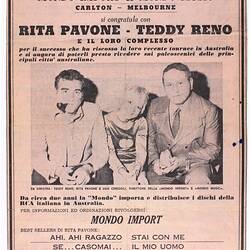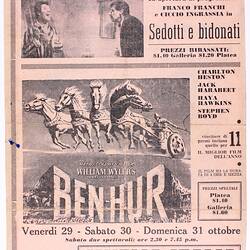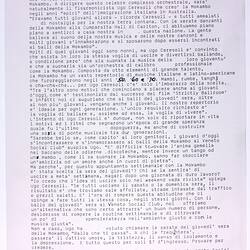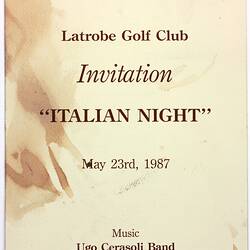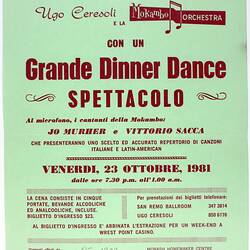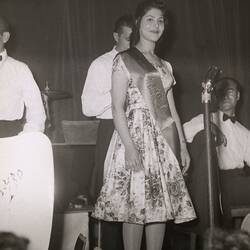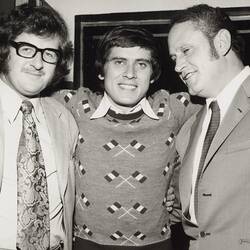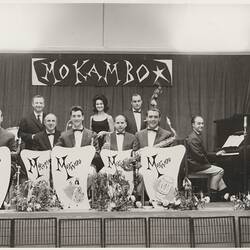Summary
The end of World War II marked the beginning of a remarkable rise in mass Italian migration to Australia that would continue for almost thirty years. Many settled in Carlton, an inner city suburb of Melbourne, which was popularly known as 'Little Italy'. For Italian migrants, it was important to maintain their culture, language and heritage. The formation of many Latino-Italian bands, such as the 'Mokambo Orchestra' led to the popularization of this style within the Italian community and the broader public.
The end of World War II marked the beginning of a remarkable rise in mass Italian migration to Australia that would continue for almost thirty years. There was a strong demand for white European labour in Australia and migrants were an integral part of Australia's post-war reconstruction and expansion program (DIBP, 2000). Facing political, social and economic uncertainty in their country, many Italians left for Australia hoping for a better life. Like many who arrived in Australia, Italian migrants were recruited 'to fill the menial jobs that native-born Australians and immigrants from Britain vacated' (Miller, 2011).
Many Italian migrants settled in Carlton, an inner city suburb of Melbourne, which was popularly known as 'Little Italy'. By 1960, 'one-quarter of the Carlton population was of Italian origin, with one-fifth actually born in Italy' (Logan, 1985).
Integration into Australian society could be difficult for Italian migrants and often local attitudes towards them were unwelcoming. Many migrants felt homesick for their families and felt that 'maintaining their link with Italy was important for their sense of identity and wellbeing. [and] to maintain their culture, language and heritage' (Co.As.It, 2008). One fundamental part of this cultural preservation was an appreciation of Italian music, encouraging the formation of many Latino-Italian bands, such as 'Ugo Ceresoli and the Mokambo Orchestra' and 'Sergio G and the Flippers'.
Latino-Italian bands playing 'ballo Italiano' led to the popularisation of this style with both Italian communities and the broader public and contributed to an increasing admiration for the Italian culture. There were many musical and social events on weekends in the Carlton area, such as the Mokambo 'ballo', where many young Italian men would attend hoping to make friends and meet potential girlfriends (Gobbo, 2010).
Dr John Whiteoak, musicologist and music historian from Monash University, defines the post-war Latino-Italian music and dance scene as 'the unrepeatable product of a unique period in Australian social history' (Whiteoak, 2007b). When describing the appeal of Latino-Italian music to the mainstream community of Melbourne, he asserts that it was the '"difference" or "foreignness"- their foreign flavour- (that) was the basis of their success as popular entertainment beyond ethnic minority patronage' (ibid, 2007b).
Gradually, assimilationist views held towards Italian-Australians gave way to 'an acknowledgement (with varying degrees of tolerance) of cultural differences' (Iuliano and Badlassar, 2008). Today, the Latino-Italian style of music is not as popular in Australia as it was in the fifties and sixties. However, there is still a place across Melbourne's diverse communities for 'the perennial sound of light dance music and Italian and European popular song' (M.A.T.I.A Music, 1987).
References
Co.As.It (2008) 'A Profile of Italian Australian Culture'. Co.As.It. Sydney, It.So.Wel. Wollongong, p. 7.
Delfi, J. (1991, November 8). Ugo Ceresoli, la Mokambo e il "ballo anti-recessione". Il Mondo, p. 25.
Department of Immigration and Multicultural Affairs (2000), Immigration and Population History of Selected Countries of Birth, Ausinfo, p. 36.
Ercole, I. (1981, June 8). Ugo Ceresoli e l'orchestra Mokambo di nuovo in pedana dopo 12 anni. Il Globo, n.p.
Gobbo, J. (2010) Something to Declare: A Memoir. The Miegunyah Press. Victoria, Australia, p. 35.
Iuliano, S. and Baldassar, L. (2008, November 3) ' Deprovincialising Italian Migration Studies: An overview of Australian and Canadian research' Flinders University Languages Group Online Review, Vol. 3, Issue. 3, P. 2.
Logan, W. (1985) The Gentrification of Inner Melbourne: A Political Geography of Inner City Housing. University of Queensland Press. Queensland, Australia, p. 30.
M.A.T.I.A Music (1987). Ugo Ceresoli. M.A.T.I.A Music, pp. 30 - 34.
Miller, P. (2011) 'Calculating Babies: Changing Accounts of Fertility Decisions amongst Italians in Melbourne, Australia'. In: Baldassar, L and Gabaccia, D. (eds.) Intimacy and Italian Migration: Domestic Lives in a Mobile World. Fordham University, Minnesota, p. 86.
Whiteoak, J. (2007). Mambo Italiano: Ugo Ceresoli and His Orchestra Mokambo. Italian Historical Society Journal, pp. 58-72.
Whiteoak, J. (2007b). "Australian Music": Music of "Place" or Music of a People? Review: The Centre for Studies in Australian Music, pp. 1-5.
More Information
-
Keywords
-
Authors
-
Article types

